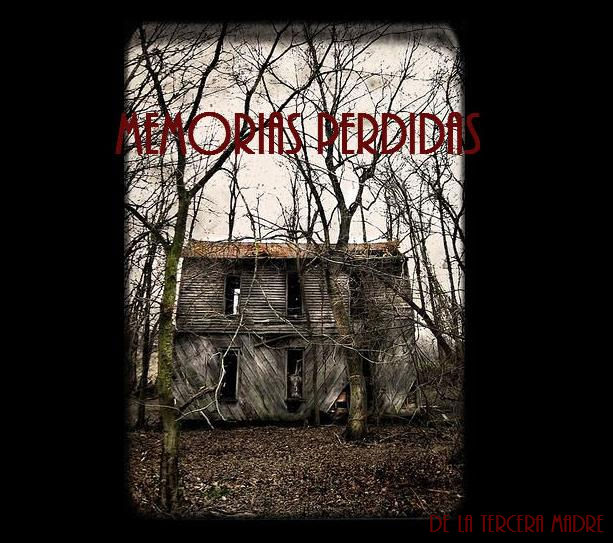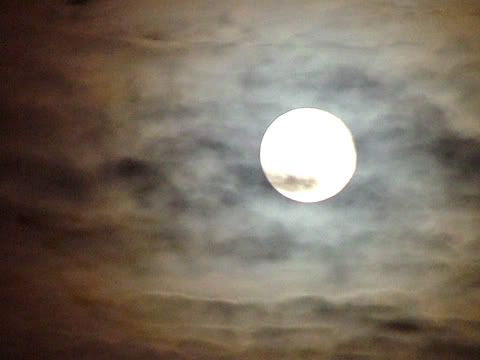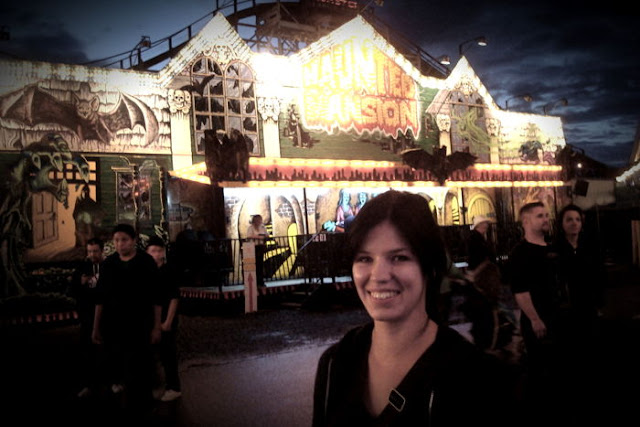Here are some vintage Halloween photos I've come across..I know these are really just kids in masks but there is just something really unsettling about them...the homemade quality really adds something extra. They really knew how to do it back then! I think Halloween has become a bit cheesy these days by contrast...
miércoles, 29 de septiembre de 2010
jueves, 23 de septiembre de 2010
Harvest Moon
Etiquetas:
nature
 Not only is the autumnal equinox here but this time, nearly after 20 years, the phenomenon has coincided with the harvest moon.
Not only is the autumnal equinox here but this time, nearly after 20 years, the phenomenon has coincided with the harvest moon.In a rare treat to the sky gazers, the full moon adorned the night sky six hours after the fall equinox.
Not only the sky watchers saw the 'wine moon' ushering the equinox, they also witnessed Jupiter shining bright, commemorating the onset of autumn.
A harvest moon during equinox is a rarity. It last happened on Sept. 23, 1991, and the next will not been seen again before 2029.miércoles, 22 de septiembre de 2010
The twisted world of Pumpkinrot
I have to give the credit to my boyfriend for this find, and it is truly an awesome one.
While browsing the web for papier mache corpse ideas, he stumbled upon www.pumpkinrot.com.
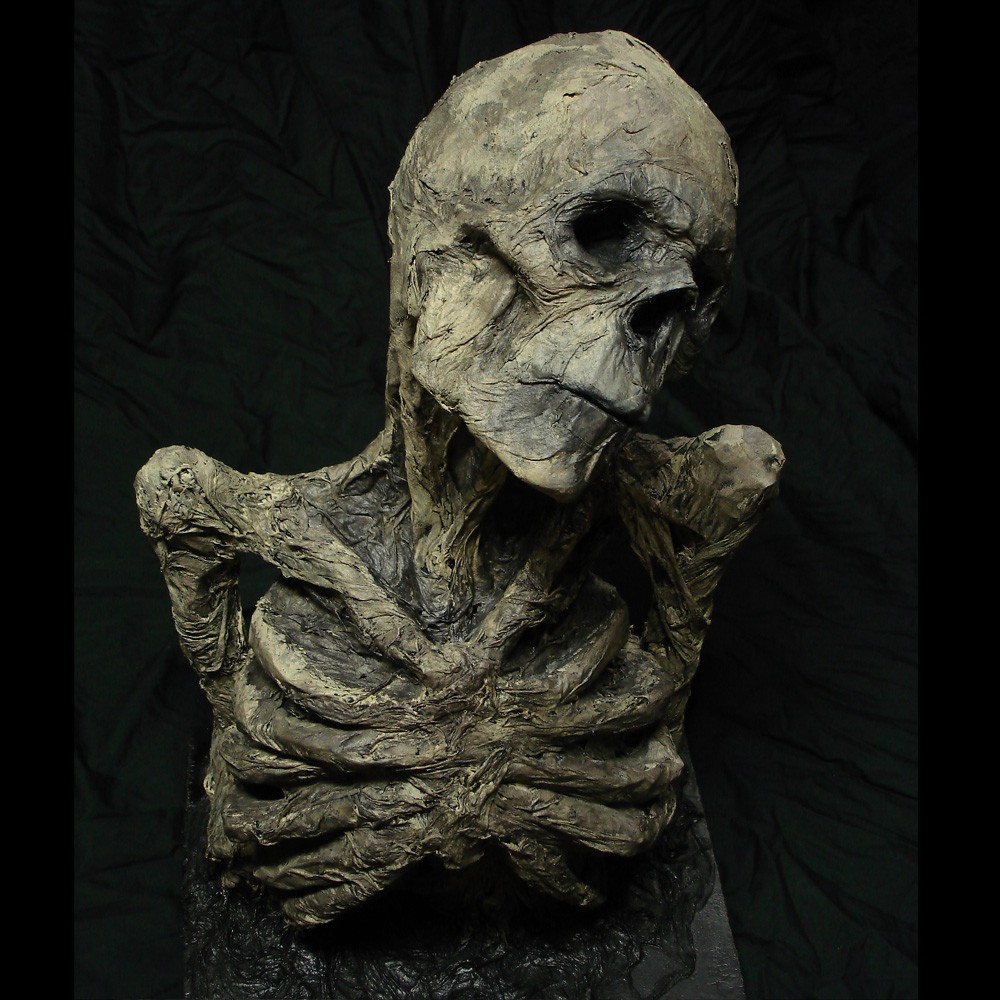 This site is the epitome of sweet Halloween do-it-yourself ingenuity.
This site is the epitome of sweet Halloween do-it-yourself ingenuity.
Whoever is responsible for these creations is clearly an artist and a master of papier mache, and he (or she) has kindly shared his techniques in detail for our reference. ^_^
Every Halloween since 2001 is documented on the site,
I especially love his use of lighting and the spooky atmosphere he has created in his scenes!
The sick and twisted creativity going into these decorations is top notch, the overall results are really impressive.
Check it out for Halloween inspiration- he also has a blog of his own! some of his goodies are even for sale...enjoy!
I especially love his use of lighting and the spooky atmosphere he has created in his scenes!
The sick and twisted creativity going into these decorations is top notch, the overall results are really impressive.
Check it out for Halloween inspiration- he also has a blog of his own! some of his goodies are even for sale...enjoy!
Here are some of the pictures from his 2009 "Corn Witch" display. We eagerly await what 2010 has to offer...
 |
| where did he find such realistic human teeth... |
lunes, 20 de septiembre de 2010
X-Ray pin-up beauties
And now presented for your enjoyment:
Some of my favourites from the new pin-up calendar from Medical imaging firm EIZO. I would love to get a copy of this, although I wonder how much radiation the models were exposed to during the making...
Creepy Carnie goodness
 Here are some pictures from the Fair I went to last weekend. It was a great time and we had the full good old fashioned carnival experience including:
Here are some pictures from the Fair I went to last weekend. It was a great time and we had the full good old fashioned carnival experience including: Scary carnival rides with the added excitement of possible sudden death due to old creaky machinery;
Vintage children's fair rides that looked like something out of a horror flick;
Creepy clowns on stilts and seven foot tall stuffed animal prizes;
Classic haunted house where the facade is 100 times more awesome than the ride and you come out feeling "we've been took." but invariably go back for more next year!
miércoles, 15 de septiembre de 2010
Etiquetas:
bizarre,
haunted house,
haunting,
historical
Mad from life's history
Swift to death's mystery
Glad to be hurled
Anywhere
Anywhere
Out of this world
Swift to death's mystery
Glad to be hurled
Anywhere
Anywhere
Out of this world
Violet Whaley suicide note
Picture taken at The Whaley House at dusk.
sábado, 11 de septiembre de 2010
"The Little Georgia Magnet" phenomenon
 |
| Lulu Hurst's Cane act |
Georgia, 1883, the nation was astounded by a young woman with seemingly unbelievable powers.
For years afterward, she and her imitators were among the most popular and controversial variety performers in America and Europe. Lula Hurst and Annie Abbott, started what would become a mysterious trend.
Lulu Hurst, the first Georgia Wonder, was born in 1869 in Polk County. In September 1883 she gained local attention by demonstrating mysterious abilities: chairs, canes, and umbrellas, held by others, seemed gripped by an invisible power when Hurst touched them lightly.
In one of her demonstrations, a volunteer, usually a burly man, held a cane horizontally in both hands. When Hurst placed her open hands on the cane, the man could no longer hold it steady.
Holding it became as difficult as "trying to hold down a flash of lightning," as one volunteer put it. In some cases the volunteer himself was pulled about by a mysterious power and even thrown to the floor.
 |
| Illustrated Newspaper on July 26, 1884. |
With such demonstrations, and the help of theatrical manager Sanford H. Cohen and newspaper editor Henry Grady, Hurst's vaudeville act was soon in demand throughout Georgia and beyond.
Hurst and her parents toured the South and Northeast in 1884, and the West and Midwest in 1884-85. By the conclusion of her northeastern tour, including highly successful appearances in Boston, New York, and Washington, D.C., Hurst, just fifteen, was one of the most famous women in the country.
In her western tour, however, Hurst found audiences increasingly uncooperative, as other women duplicated her act and observers explained her feats. In fall 1885 Hurst cancelled a tour of Europe, retired from the stage, and retreated into silence.
 Hurst refused to discuss her career or her powers until 1897, when she published a best-selling autobiography that gave a selective account of her tours and an explanation of her methods.
Hurst refused to discuss her career or her powers until 1897, when she published a best-selling autobiography that gave a selective account of her tours and an explanation of her methods. She then resumed her silence about her theatrical years and maintained it to her death on May 13, 1950.
Hurst's fame and substantial earnings inspired many imitators, including Mattie Lee Price of Bartow County and Mamie Simpson of Marietta, but the most successful was known as "Annie Abbott, the Little Georgia Magnet."
Annie Abbott born Dixie Annie Jarratt in 1861, married Charles N. Haygood when she was seventeen. The couple apparently witnessed Hurst's performances in Milledgeville in 1884 and February 1885, and Dixie Haygood first performed her version of Hurst's act publicly in early March 1885. She soon adopted the stage name Annie Abbott.
 After her husband's death in 1886, Abbott supported herself and her children by gradually expanding her tours to include northern cities. In 1891 a successful run in New York City led to performances in London, England.
After her husband's death in 1886, Abbott supported herself and her children by gradually expanding her tours to include northern cities. In 1891 a successful run in New York City led to performances in London, England. She was enormously successful there, performing at the Alhambra Theatre before packed houses for six weeks. She then toured Europe and Russia for nearly two years, literally performing, in the old theatrical phrase, "before all the crowned heads of Europe."
Her success was in part due to her creation of new and remarkable effects, including the apparent ability to resist being lifted from the floor by male strength and thereby to defy physics (hence her nickname, the "Georgia Magnet"). Abbott's performances were also more impressive than Hurst's because Abbott was a smaller woman, a petite 100 pounds, and clearly unable to achieve her effects by weight or physical strength.
Like Hurst, Abbott was frequently examined by physicians and others, who were usually baffled by her feats. Newspapers often revealed her methods (which, like Hurst's, employed the clever and practiced use of leverage and center of gravity, along with the power of suggestion), but Abbott continued performing. Her popularity was undiminished, perhaps because the controversy generated by the exposés drew larger audiences.
 She was imitated by many; some even used her stage name, both during her lifetime and afterward, thus clouding the history of the real Abbott. She died on November 21, 1915, and is buried in Memory Hill Cemetery in Milledgeville.
She was imitated by many; some even used her stage name, both during her lifetime and afterward, thus clouding the history of the real Abbott. She died on November 21, 1915, and is buried in Memory Hill Cemetery in Milledgeville. Controversy followed these Georgia Wonders for decades, in part because their demonstrations raised questions about both the paranormal and women's abilities and roles, two prominent cultural debates of the late nineteenth century.
This book is the complete, documented story of the life of Milledgeville, Georgia's Dixie Haygood, who as Annie Abbott, "The Little Georgia Magnet," captivated the world and puzzled scientists in the late 1800s and early 1900s with her unexplained power.
Her exhibitions of strength became known worldwide as the "Annie Abbott Act." The magician, Harry Houdini, described her opening performance at the Alhambra Theater as one of the three big sensations of the London vaudeville stage.
Her exhibitions of strength became known worldwide as the "Annie Abbott Act." The magician, Harry Houdini, described her opening performance at the Alhambra Theater as one of the three big sensations of the London vaudeville stage.
 Dixie Haygood, who weighed only 96 pounds, used her extraordinary power to overcome the strongest men in the world. When she willed it, strong men could not lift her. She could also transfer her power to children, who then were unable to be lifted! She performed these and many other exhibitions. She performed before all of the crowned heads of Europe, giving exhibitions involving her audiences and baffling men of science.
Dixie Haygood, who weighed only 96 pounds, used her extraordinary power to overcome the strongest men in the world. When she willed it, strong men could not lift her. She could also transfer her power to children, who then were unable to be lifted! She performed these and many other exhibitions. She performed before all of the crowned heads of Europe, giving exhibitions involving her audiences and baffling men of science. For the first time -- the true story of the creation of the world famous Annie Abbott Act is revealed through hundreds of eyewitness accounts and her own diary. It is only through her diary, autograph album and pain-staking research that her true, and unusual, life has been revealed.
The story of Dixie Haygood and Annie Abbott is not simply about this one woman. Her success as Annie Abbott gave rise to imitators, including Annie May Abbott, whose identity and complex relationship with Annie Abbott is explained for the first time.
The lives of Annie Abbott, Annie May Abbott, their managers and their families are interwoven in remarkable and never before known ways.
miércoles, 8 de septiembre de 2010
Alexander, The Man Who Knows
Etiquetas:
bizarre,
historical,
illusion,
magician,
Men
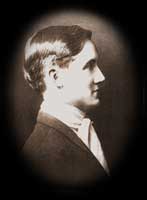 Between 1915 and 1924, Alexander, billed as The Man Who Knows, astounded theater audiences, performing feats of mind-reading and psychic prediction that defied explanation. Cloaked in exotic robes from the Orient, wearing a jeweled turban and holding his trademark gazing globe, Alexander dominated the stage for nearly a decade before retiring in 1924, at the age of 43, the richest man in vaudeville.
Between 1915 and 1924, Alexander, billed as The Man Who Knows, astounded theater audiences, performing feats of mind-reading and psychic prediction that defied explanation. Cloaked in exotic robes from the Orient, wearing a jeweled turban and holding his trademark gazing globe, Alexander dominated the stage for nearly a decade before retiring in 1924, at the age of 43, the richest man in vaudeville. A skilled stage magician, Claude Alexander Conlin thrilled audiences in his famous physic act during which he would answer questions from the audience that were delivered to the stage in sealed envelopes.
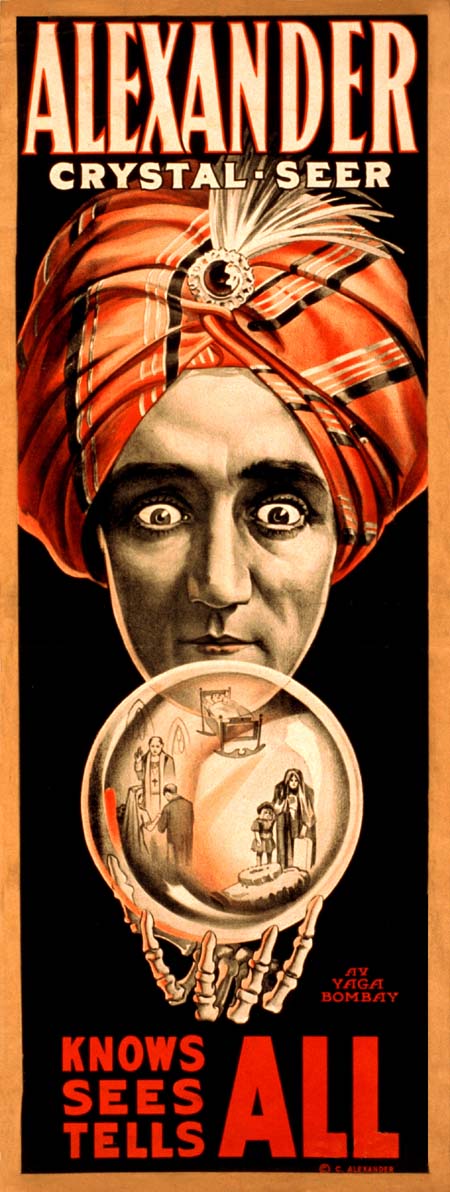 At the height of his career, he sold out theaters across the United States and Canada for weeks at a time, making millions from box office receipts, and from the sale of books, crystal balls, and related merchandise.
At the height of his career, he sold out theaters across the United States and Canada for weeks at a time, making millions from box office receipts, and from the sale of books, crystal balls, and related merchandise. He traveled the world, and counted among his friends such show-business luminaries as Alexander Pantages, John Considine, Rudolph Valentine, and Clara Bow.
The magician waged open war with anyone who dared try to debunk him, including the Great Houdini, among others. He would quickly decode and then expose the secrets and elaborate techniques used by his rivals to fool audiences.
He even provided blueprints for the manufacture of psychic act stage props, and revealed the famous "Zancig Code" pioneered by the mentalists Julius and Agnes Zancig.
Alexander was the highest-paid mentalist in the world during his time, whose personal life was kept quiet until recently when a surviving granddaughter inherited a scrapbook of memoirs from her grandfather Alexander.
Surviving members of Alexander's family interviewed by David Charvet say that Alexander had "seven marriages (sometimes to more than one woman at once), spent time in local jails and federal prison, went on trial for attempting to extort an oilman millionaire, made a failed attempt to out run the authorities in a high powered speed-boat loaded with bootlegged liquor, and admitted killing four men."
 Other sources say Alexander had a total of eleven marriages throughout his lifetime, some of which were to married women. Many say he also dabbled in bootlegging, some say opium, and possibly the white slave trade.
Other sources say Alexander had a total of eleven marriages throughout his lifetime, some of which were to married women. Many say he also dabbled in bootlegging, some say opium, and possibly the white slave trade. Alexander has been described by many accounts as a fraud and a con-man. And granted, Alexander made an absolute fortune off his supposed ability as a Seer. But the question of whether he totally discounted paranormal phenomena and spiritualism is somewhat unclear.
He published a book called The Life And Mysteries Of The Celebrated Dr. Q in 1921, about the magic trade, exposing tricks and secrets. However he also put out a lot of genuine material on spiritualism and the New Thought Movement such as his The Inner Secrets of Psychology, and Personal Lessons, Codes, and Instructions for Members of the Crystal Silence League that suggest he found elements of truth in the subject matter.
Upon retiring Alexander passed the turban and sold his entire act, image and publicity to mentalist Robert Nelson, who went on to perform under his name for some time after.

It would seem that the private life of Alexander was just as bizarre and surprising as his life on the stage; the secrets of his technique have never been fully revealed, but his fame or infamy can be attributed to his remarkable showmanship, and his ability to allow people to believe the unbelievable.
Information and images from:
The Man Who Knows by David Charvet, 2007
http://www.mrmagician.co.uk
www.generalrubric.com/magicposters
The Life And Mysteries Of The Celebrated Dr. Q (also known as The Dr. Q. Book) (1921, Alexander Publishing Co., Los Angeles, California; later reprinted by Robert Nelson, Columbus, Ohio)
The Inner Secrets of Psychology Vol. 1, 1924. (and an unknown number of further volumes)
Personal Lessons, Codes, and Instructions for Members of the Crystal Silence League, C. Alexander Publishing Co. n.d. (c. 1925 - 1930)
domingo, 5 de septiembre de 2010
Suscribirse a:
Entradas (Atom)
